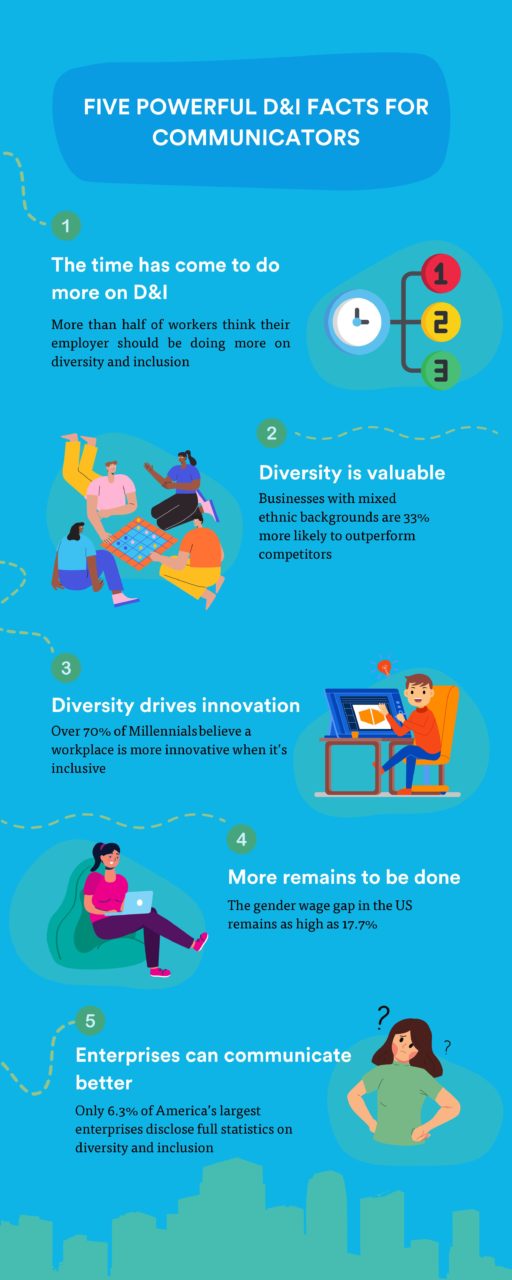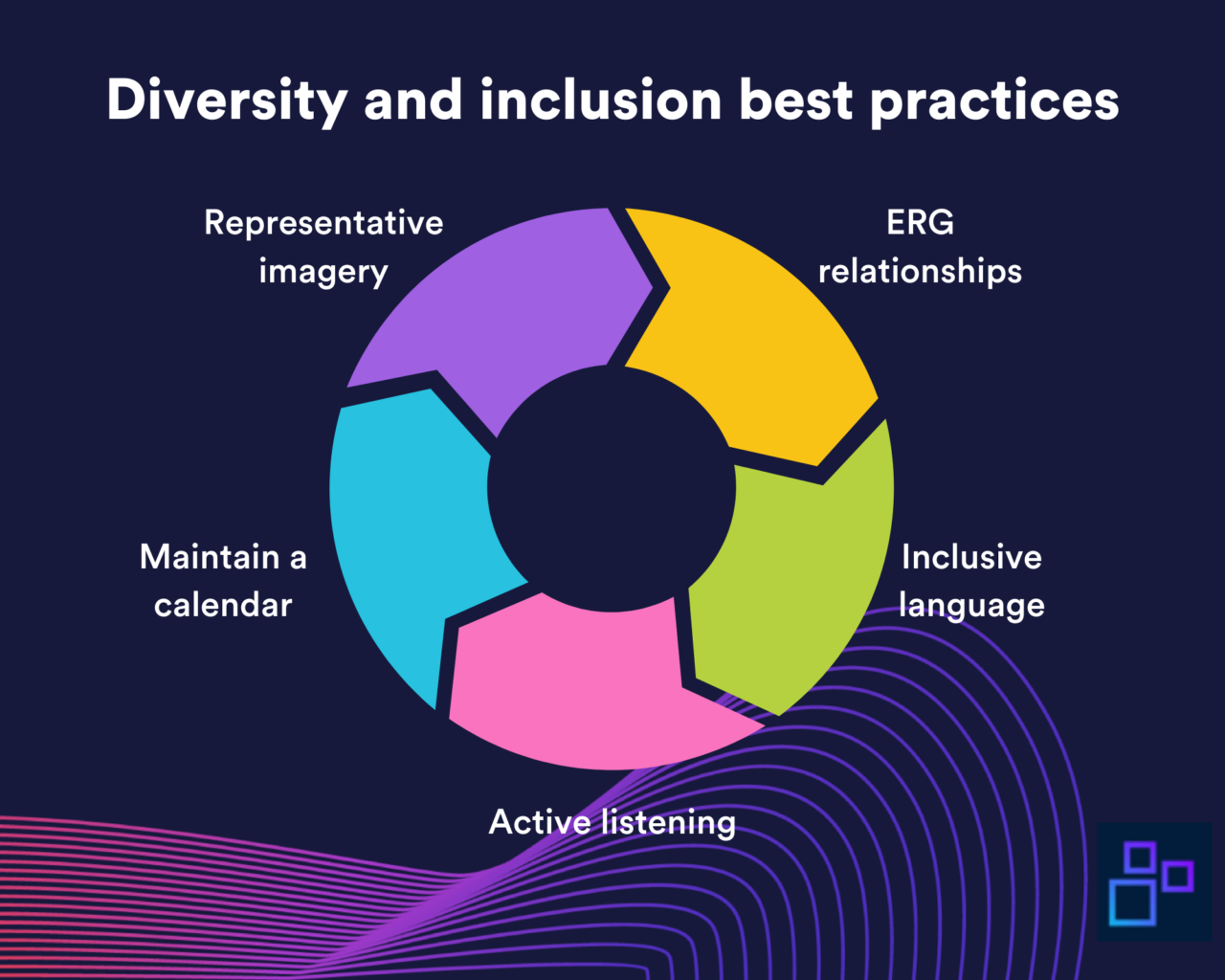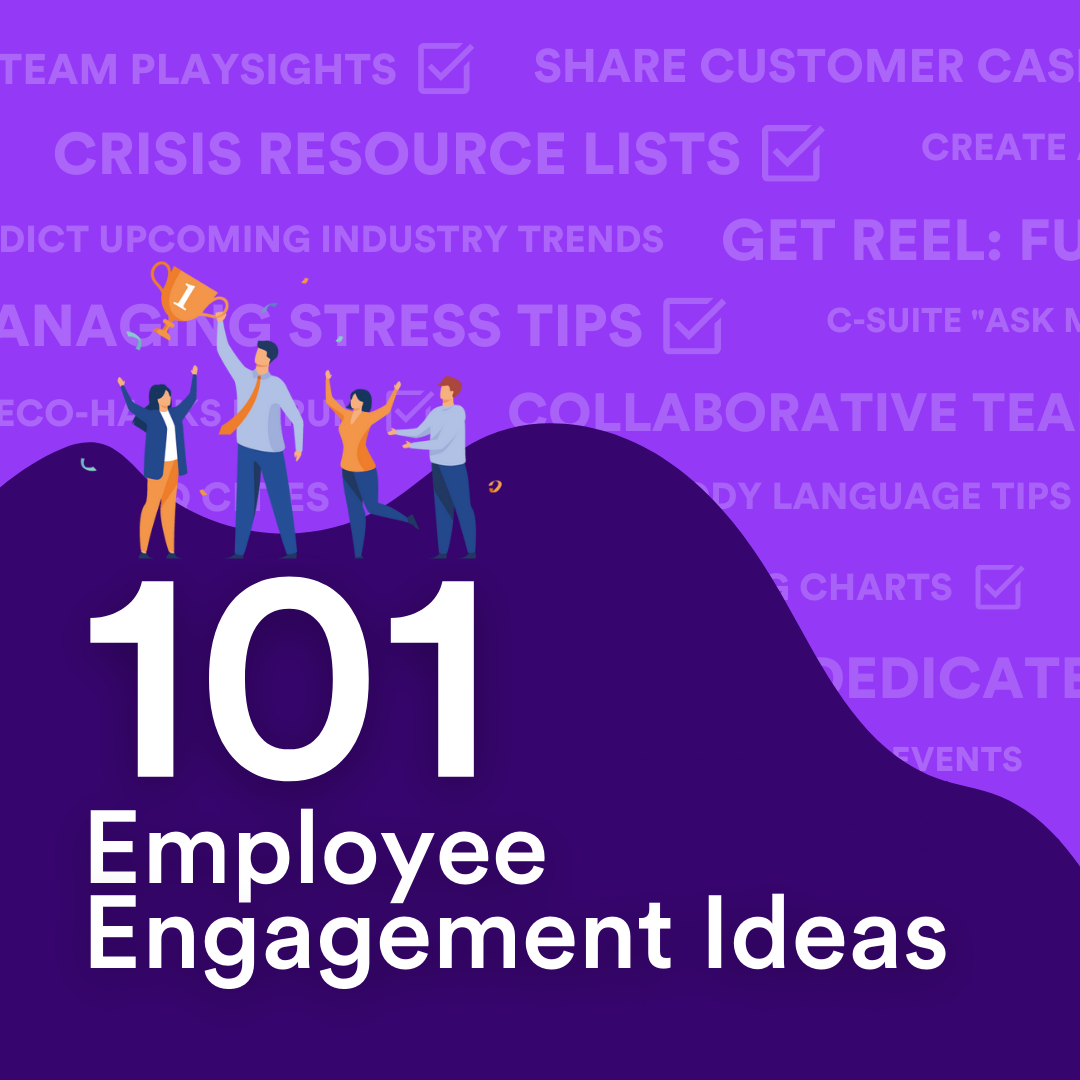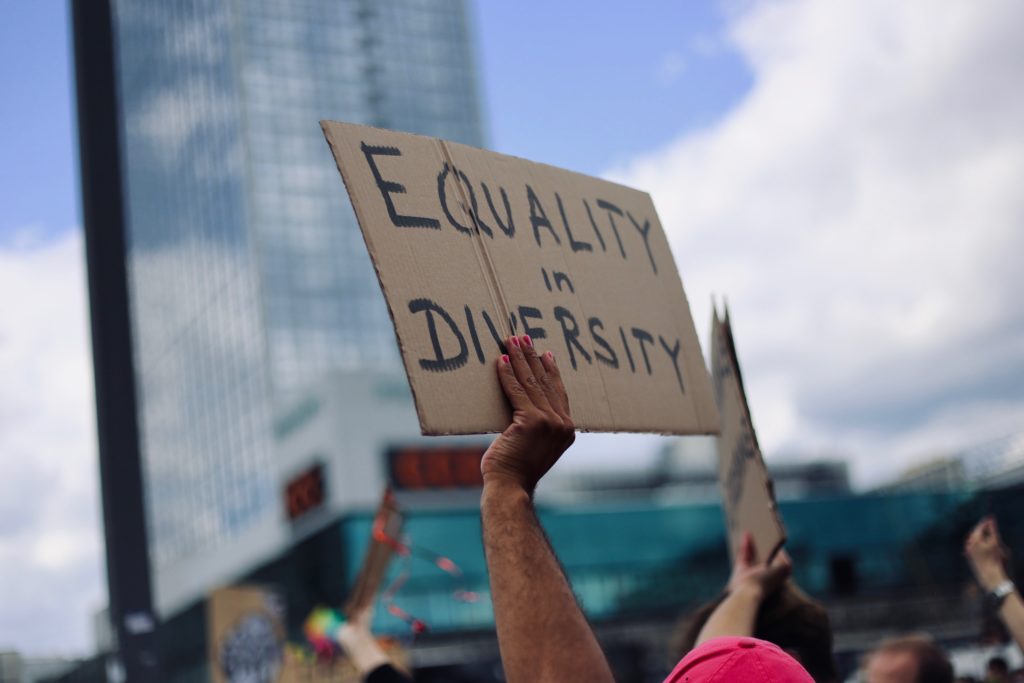With Pride Month 2022 almost here, it’s a great moment for organizations to consider their diversity and inclusion communications. This blog dives into the key DE&I facts communicators need to know in 2022 and offers best practices and practical tips on promoting diversity and inclusion at work.
For many companies, Pride Month is a welcome opportunity to celebrate LGBTQ+ colleagues internally (and externally) and to reflect on how diversity and inclusion communications more broadly can support the creation of better corporate cultures.
Diversity, equity, and inclusion have been important topics for many years, but they have become especially resonant in light of socio-political movements such as #MeToo, Black Lives Matter, and trans rights.
Keep communications fresh with 101 Employee Engagement Ideas
In 2022, how employers approach their diversity and inclusion communications must also be seen through the lens of generational shift (Millennial and Gen-Z individuals routinely cite DE&I as a must-have) and the Great Resignation. In repeated surveys of global workers, staff have suggested that being part of a positive and inclusive work culture, being valued as an individual, and being connected to organizational purpose are critical reasons for them to stay or leave.
Internal communicators have a valued role in distributing and celebrating diversity and inclusion communication. By connecting colleagues with the right information, they highlight the good work taking place within a company and hopefully contribute to positive change.
Given everything that’s happening in our workplaces, what do communicators need to know about DE&I in 2022? We’ve compiled some powerful facts and best practice tips you can use to contribute to debates and embed diversity and inclusion communications even further.
Powerful diversity and inclusion statistics for 2022

The value of diversity
- Employees who perceive their organization is committed to diversity are 80% more likely to believe they work in a high-performing company (Deloitte)
- Inclusive companies enjoy 2.3 times higher cash flow per employee over three years (Josh Bersin)
- More than 3 out of 4 job seekers and employees say that diversity is important to them when evaluating companies (Glassdoor)
- Companies with above-average management diversity have 19% more revenue from innovation (BCG)
- Businesses with mixed ethnic backgrounds are 33% more likely to outperform competitors (Global Diversity Practice)
Gender
- More than a quarter of women (29%) report being unsupported with career development (Accenture)
- The pandemic hit women harder, with 10% more women reporting workplace burnout than male colleagues (McKinsey)
- The gender wage gap in the US remains as high as 17.7% (OECD)
- Almost 60% of women regularly experience microaggressions at work (IWD)
- Just 5% of companies globally have a female CEO (Equileap)
Keep communications fresh with 101 Employee Engagement Ideas
Ethnicity
- Black British workers with degrees earn 23.1% less on average than their White counterparts (Equality and Human Rights Commission)
- In a Gallup survey, 31% of Asian Americans and Pacific Islanders (AAPIs) reported incidents of employment discrimination, the largest of any group (The White House)
- Over 40% of Black private-sector workers earn under $30,000 per year, compared with 29% of the private sector on average (McKinsey)
- Compared to an average of 31.4%, only 16.2% of Hispanic workers can work from home (EPI)
- It will take around 95 years for Black employees in the US to reach equal representation across all levels of the private sector (McKinsey)
Neurodiversity and disability
- In the US, around 85% of individuals on the autism spectrum are unemployed, compared to an average rate of 4% unemployment in the population as a whole (HR Review)
- JPMorgan Chase found that members of its Autism at Work initiative made fewer errors and were more productive than neurotypical co-workers (Forbes)
- Around half of UK employers admit they would not hire someone with one or more neurodivergent conditions (Institute of Leadership and Management)
- Staff turnover is up to 30% lower when organizations have well-run disability community outreach programs (Accenture)
- Out of approximately 56 million people with disabilities in the US, 13.3 million reported difficulty finding a job despite seeking work (Workplace Initiative)
LGBTQ+
- Over 45% of LGBTQ+ workers report experiencing unfair treatment at work, including being fired, not hired, or harassed (UCLA School of Law)
- Transgender adults are twice as likely to be unemployed in the US as cisgender adults (McKinsey)
- Nearly half (46%) of LGBTQ+ workers feel they must hide their identity in the workplace (HRC Foundation)
- Fewer than 0.3% of Fortune 500 board directors are openly LGBTQ+ (Out Leadership)
- Transgender workers make 32% less a year than cisgender counterparts, even when educational attainment is similar (McKinsey)
There’s much more to do
- More than half of workers think their employer should be doing more on diversity and inclusion(Glassdoor)
- Only 6.3% of America’s largest enterprises disclose full statistics on diversity and inclusion (Just Capital)
- Over 70% of Millennials believe a workplace is more innovative when it’s inclusive (World Economic Forum)
- Six in ten Gen-Zers and 56% of Millennials think systemic racism is widespread (Deloitte)
Keep communications fresh with 101 Employee Engagement Ideas
Best practices for diversity and inclusion communications
The facts above show that not only are there ongoing disparities that need to be corrected but that workers greatly value knowing how organizations are improving diversity, equity, and inclusion. This is where internal communications come in.
Communicators are typically asked to do three things:
- Drive better access for and encourage participation from diverse voices
- Provide information and updates on new or existing D&I initiatives
- Educate and support all employees to adopt inclusive attitudes at work
How can you achieve these goals? We rounded up some tips and best practices from communications professionals across the web. If you want to learn more about D&I at the Best Places to Work, check out our blog for even more.

Include representative photography
It can be tempting to rely on stock photography when creating internal communications, but this can reinforce unconscious bias. Be conscious about the images you use and you may encourage inclusion across your organization (Ragan).
Cultivate ERG relationships
Sharing news of employee advocacy groups can be a powerful way to unite diverse communities The stories won’t always fall in your lap though so connect with ERG group leaders and promote what they’re doing and how they’re fostering inclusion (Tribe).
Be wary of non-inclusive language
Words can be unintentionally exclusive. Consider your words carefully and use “inclusive language aims that avoid any terms that exclude certain groups of people” (WBD). For more on the amazing way that technology can now support you to write inclusively, see the details on our inclusivity checker.
Balance your dimensions
You’ll likely only have a limited amount of space to send communications, and it can be difficult to cover everything. Consider breaking your calendar down into internal, external, and organizational ‘dimensions’. That should ensure you’re creating inclusive content that intersects with many different identities (Scarlettabbott).
Facilitate listening
The organizations that lead on diversity and inclusion communications understand that listening is as important as speaking. Support employees to tell their stories by setting up internal town halls, advocacy meetings, and open sessions with senior leaders. It can lead to a stronger workplace for all (Josh Bersin).
Keep communications fresh with 101 Employee Engagement Ideas
Use the calendar
Religious holidays, national days, celebratory months: these all happen regularly and can be a source of pride for employees who want to share their own stories with the rest of the organization. Perhaps they want to explain why people fast during Ramadan or why marking Pride Month is important for their identity. Providing people with a place to share their stories is essential and an internal communications calendar can help (Interact).
Diversity and inclusion in 2022
The increasing focus on diversity, equity, and inclusion is welcome in our workplaces. As the key facts about D&I mentioned above indicate though, although much has already been done there is still a long way to go. So, what’s the state of diversity and inclusion within companies in 2022?
Ragan’s 2022 Communications Benchmark Survey is a good indicator of what people involved in delivering D&I initiatives think. The poll received responses from over 1,000 communications professionals, and their input suggests that D&I is receiving the time and investment promised throughout 2020 and 2021.
In fact, 74% of respondents said that their organizations had done more in 2021 than previously.
In terms of what those organizations did, 60% developed better strategic plans, 59% held open conversations within their businesses, 57% implemented training for workers, and many others made efforts such as bringing in expert speakers or changing HR policies.
Predictably, many communications peers admitted that the road towards a better state remains long and unclear. Concerns about transparency, a lack of measurable goals, and not having enough presence with senior leadership were all voiced.
Comms, HR, and other people-centric teams will continue to lead these critical conversations about how we all get fairer, more diverse workplaces. We hope that some of the diversity and inclusion communications best practices and facts above help you in this important work.
Read more:


